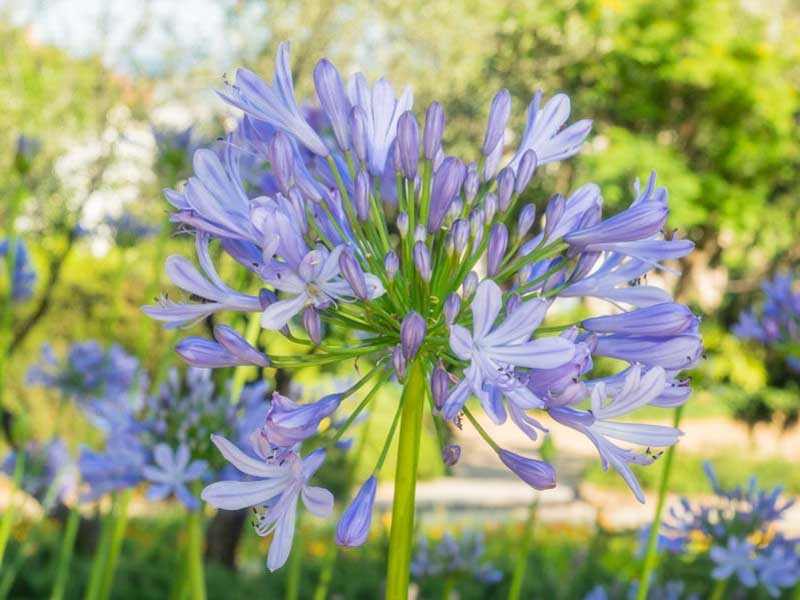Grasping the Art of Agapanthus Treatment: Important Steps for Healthy And Balanced Growth and Dynamic Blossoms
In the world of cultivation, the farming of agapanthus stands as a fulfilling endeavor for those who look for to support these stylish flowering plants. From selecting the appropriate variety to grasping trimming methods, the journey towards cultivating growing agapanthus plants is complex and holds the crucial to opening the full possibility of these herb treasures.

Selecting the Right Agapanthus Variety

When picking the appropriate Agapanthus range for your yard, take into consideration factors such as environment viability, blossom shade, and growth practice. Additionally, consider the environment in your region to guarantee the Agapanthus selection you choose can thrive in your certain conditions. Comprehending the growth habit of different Agapanthus varieties is essential for correct positioning within your yard.
Suitable Growing Problems
Considering the optimum environmental requirements is crucial for successful Agapanthus cultivation. Agapanthus plants are delicate to cool temperature levels and need to be protected from frost during winter season months.
To make certain healthy development and vivid blooms, plant Agapanthus bulbs at a depth of regarding 2-4 inches and space them 8-12 inches apart. Mulching around the base of the plants assists retain dampness and reduces weed development.
Watering and Fertilizing Tips
Preserving correct dampness levels and offering vital nutrients are essential elements in the treatment routine for Agapanthus plants. When it concerns watering Agapanthus, it is vital to strike an equilibrium. These plants favor consistently wet soil however are at risk to root rot if overwatered. During the expanding season, water deeply when a week, ensuring the soil is well-draining to stop waterlogging. In hotter environments or throughout periods of dry spell, more frequent watering might be required to maintain the dirt evenly damp. However, reduce watering in the winter season to stop water logged conditions.
Fertilizing Agapanthus is essential for promoting healthy growth and prolific blossoms. Use a balanced plant food, such as a 10-10-10 formula, in the very early spring as new development emerges. Repeat this application every 6-8 weeks throughout the expanding season. Stay clear of excessive fertilizing, as it can cause lush foliage at the expenditure of flowers. Constantly comply with the producer's guidelines for appropriate dilution and application techniques. By complying with these watering and fertilizing ideas, you can guarantee your Agapanthus plants flourish and generate vibrant, lasting flowers.
Pruning Methods for Agapanthus
Trimming Agapanthus plants at the ideal times and with correct techniques is essential for preserving their wellness and promoting ideal growth and flowering. The perfect time to trim Agapanthus remains in late wintertime or very early spring prior to new development emerges. Beginning by removing any yellowing or dead leaves near the base of the plant. Cut them as close to the ground as possible without damaging the arising shoots.
For flowered stems, wait until the blooms have actually withered and after that cut them back to the base. This not just cleans the plant's appearance however additionally motivates the development of new blossom buds. Deadheading invested blossoms can additionally redirect the plant's power right into creating even more blossoms instead of establishing seeds. Nevertheless, if you intend to collect seeds for breeding, leave some flowers to fully grown and dry on the visit our website plant.
Bear in mind to utilize clean, sharp devices to make exact cuts and decrease the risk of introducing conditions. Agapanthus. Normal trimming will certainly aid keep your Agapanthus looking healthy and balanced and neat while ensuring a bountiful display of attractive blossoms
Managing Typical Pests and Conditions
After making sure correct pruning strategies for Agapanthus, it is crucial to address usual parasites and illness that can impact the health and wellness and vitality of these plants. One typical insect that influences Agapanthus is the Agapanthus gall midget.
Additionally, Agapanthus plants can experience from root rot if they are grown in inadequately draining pipes soil. By being vigilant and taking prompt More Help action versus parasites and diseases, you can assist your Agapanthus plants flourish and generate dynamic blossoms. Agapanthus.
:strip_icc()/agapanthus-africanus-b959396b-5696f86e059c46f299d1834ba687c6eb.jpg)
Conclusion
Finally, grasping the art of agapanthus care includes selecting the appropriate range, offering ideal growing problems, appropriate watering and feeding, appropriate pruning strategies, and dealing with usual bugs and diseases. By adhering to these crucial steps, you can make certain healthy and balanced development and vivid blossoms for your agapanthus plants. Bear in mind to routinely check and preserve your plants to promote their overall well-being and longevity.
To make sure YOURURL.com healthy development and dynamic blossoms, plant Agapanthus bulbs at a deepness of about 2-4 inches and space them 8-12 inches apart. By following these watering and fertilizing pointers, you can guarantee your Agapanthus plants prosper and generate vibrant, lasting blooms.
One usual insect that affects Agapanthus is the Agapanthus gall midge. Furthermore, Agapanthus plants can endure from root rot if they are grown in poorly draining pipes soil. By adhering to these essential steps, you can ensure healthy and balanced growth and vibrant blossoms for your agapanthus plants.
Comments on “Growing Agapanthus: A Total Overview to Beautiful Blooms”